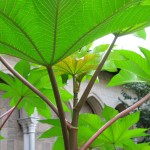Above: Stems and leaves of Ricinus communis
Widely naturalized throughout the tropics, castor bean (Ricinus communis) is??commonly grown as an ornamental annual in??American and European gardens, but it is also??a??crop plant of worldwide economic importance.??In a tropical environment, the castor bean attains the status of a thirty-foot tree. Even in temperate zones, it can reach a height of fifteen feet in a single season. An ancient medicinal plant of African origin,??castor bean??was employed by the Egyptians as a cathartic and is among the plant remedies??found??in the Ebers Papyrus. ??Like other members of the??Spurge family (Euphorbiaceae), the plant is poisonous. Dioscorides, writing in the first century, refers to the??plant??by its Egyptian name, kiki, as well as its Greek and Roman names: kroton and ricinus.?? The last two names derive from the Greek and Latin words for “tick,”?? because of a fancied resemblance of the??seed to the parasite.
Although he remarked on the plant’s purgative properties, Dioscorides considered Ricinus to be too harsh and violent for internal use. He??recommended that the bruised leaves be used externally??against swelling and inflammation of the eyes and skin.
The Arbor mirabilis described by the great thireenth-century Dominican theologian and natural philosopher Albertus Magnus has??been identified as Ricinus communis. (Jerry Stannard, Pristina Medicamenta: Ancient and Medieval Botany, 1999.)????Castor bean??was also known to the Middle Ages as Palma Christi, in reference to the large palmate leaves, but that name was also given to a species of orchid whose tubers resembled a hand.?? It is not always certain which medicinal plant??was??meant??by medieval authors.??The Hortus Sanitatis, a fifteenth-century herbal, credits Palma Christi with the power to benefit the stomach, to heal ulcers and erysipelas, and to soothe the eyes, among other virtues.??While some of these??are similar to those which Dioscorides attributed to Ricinus, no mention is made in the medieval source of??the plant’s??purgative action or its dangers. (Frank Anderson, German Herbals??through 1500, 1984).
The seeds??of Ricinus communis are drastically purgative and very poisonous and are the source of the potent phytotoxin known as ricin.?? (Ingestion of the seeds??is dangerous but not necessarily??fatal, as they must be chewed in order for the toxin to be released. ) ??Castor oil, which was used in antiquity as a lamp oil,??is extracted from the seeds and has many commercial and industrial applications, as a lubricant, a biofuel, and a??food and drug??additive. The ricin??which the raw seeds contain is eliminated in the process of extraction, and the oil is innocuous, if unpalatable.??Castor oil was widely used as a mild laxative??in this country??as late as the mid-twentieth century, and generations of children were regularly dosed with??a spoonful.
—Deirdre Larkin
Tags: castor bean, Castor ricinus, medicinal plant, poisonous plant

